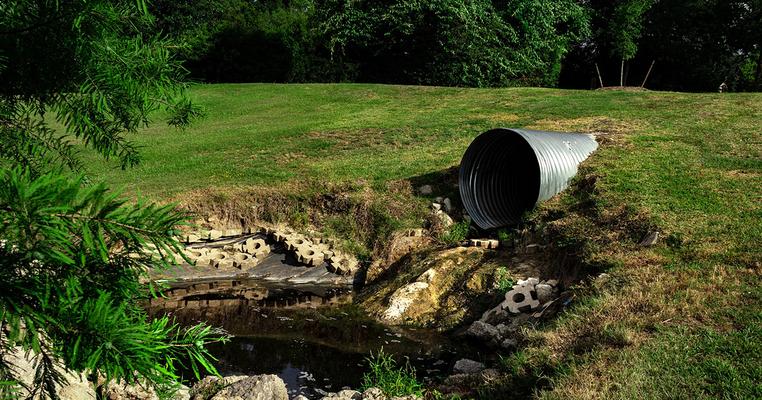
Climate Change Could Spell Disaster for Superfund Sites
Since 1980, the EPA’s Superfund program has been identifying, analyzing, cleaning up, and containing sites contaminated with hazardous waste across the United States. The program was created in the wake of the 1970s Love Canal disaster near Niagara Falls, where decades worth of toxic chemical dumping ended up harming hundreds of local residents.
Superfund sites include manufacturing facilities, processing plants, landfills, and mining sites. The Superfund program gives the EPA the authority to clean up contaminated sites or force the parties responsible to do so themselves. One of the program’s overarching goals is to protect human health and the environment through cleanups, an effort that is proving to be an increasing challenge with the threat of climate change.
Superfund sites have a range of impacts on human health. Continued exposure to the hazardous substances released from a Superfund site into the air, surface water, and groundwater can be incredibly detrimental to human health in areas surrounding the site.
Studies over the years have shown higher levels of cancer, birth defects, developmental disabilities, and other serious health issues in communities located near Superfund sites. Children, pregnant women, and the elderly are especially at risk for these health effects. Superfund sites have been correlated with lower standardized test scores, higher rates of suspension and repeated grade levels, and decreased cognitive functioning in students.
And the threat doesn’t stop there – Superfund sites are made even more dangerous by impacts of the climate crisis.
Climate Change and Superfund Sites
Climate change may increase the frequency and severity of certain natural disasters — notably wildfires, hurricanes, and floods—which can damage Superfund sites and expand their reach, so to speak, far past their physical boundaries.
Despite Superfund sites being identified and barricaded for public safety, many of them remain dangerously close to densely populated and/or heavily visited areas.
Put plainly: The likelihood of chemical dispersion from natural disasters grows alongside the threat of climate change.
A 2019 report from the US Government Accountability Office (GAO) found that “about 60 percent (945 of 1,571) of all non-federal Superfund National Priorities List (NPL) sites — which have serious hazardous contamination — are located in areas that may be impacted” by flooding, storm surge, wildfires, and sea level rise. As these natural hazards become even more frequent due to climate change, the potential for these sites to release contaminants into unsuspecting communities rises.
This is not just a prediction. We’ve seen it already.
Dioxins, chemicals that can cause cancer and liver and nerve damage, were dumped in and around the San Jacinto River near Houston by paper mills in the 1960s. In 2011, by EPA requirement under the Superfund program, the responsible parties installed a temporary cap over the waste. However, during Hurricane Harvey in 2017, heavy damage to the cap resulted in high levels of dioxins detected in the area.
In Bridgewater, New Jersey, one site contained “contaminated soil and groundwater from 27 unlined chemical waste lagoons stemming from more than 90 years of chemical and pharmaceutical manufacturing.” The site was heavily flooded by Hurricane Irene in 2011.
These are just two examples of the many climate impacts on Superfund sites.
New Orleans, Florida, and New York City are all extremely vulnerable to sea level rise. They also happen to have the highest concentrations of Superfund sites in the US in their respective radiuses.
A Better Plan…
The Superfund program itself comes with its own set of difficulties for implementation.
Most importantly, the caveat where major cleanup decisions are left to the private companies that created the messes can lead to inefficient or superficial remediation efforts. Waste may be shipped to treatment plants that are not equipped to handle it for inexpensive disposal with little oversight. Companies may also be hesitant to change to more environmentally-conscious technologies in favor of their own profits — and can technically make the argument to the EPA that they are still following their cleanup plans.
It’s not that the EPA has done nothing to address climate resilience in the Superfund program. It’s that there is very little direction on how to implement these plans within site-level decision-making.
Their approach involves “periodic screening of Superfund remedy vulnerabilities, prioritizing the Superfund program's steps to adapt to a changing climate and identifying measures to assure climate resilience of Superfund sites.” But the guidance and resources needed to implement these necessary changes are limited. The GAO report recognized “institutional, resource, and technical challenges in managing risks from climate change effects,” with some EPA officials stating that they “do not have the direction they need to manage these risks.”
…for a Better Tomorrow
President Biden and EPA Administrator Michael Regan have been working hard to keep the environmental justice promises they’ve made. But they also have yet to take comprehensive action to expand the Superfund program into a broader climate initiative.
In September 2021, Regan stated that “at its core, EPA’s Superfund cleanup program is about protecting people’s health.” To see this goal through, however, the Superfund program must update its current priority actions to meet the relevant goals of the EPA’s 2021 Climate Adaptation Action Plan.
Hazardous waste sites and climate change go hand-in-hand. They create a positive feedback loop that does further and further harm to the environment and human health.
It’s well past time for us to consider Superfund sites as another aspect of the climate crisis – and act accordingly.
Sign up below to join Climate Reality’s email list and we’ll keep you posted on the latest developments in climate policy and how you can help solve the climate crisis.

